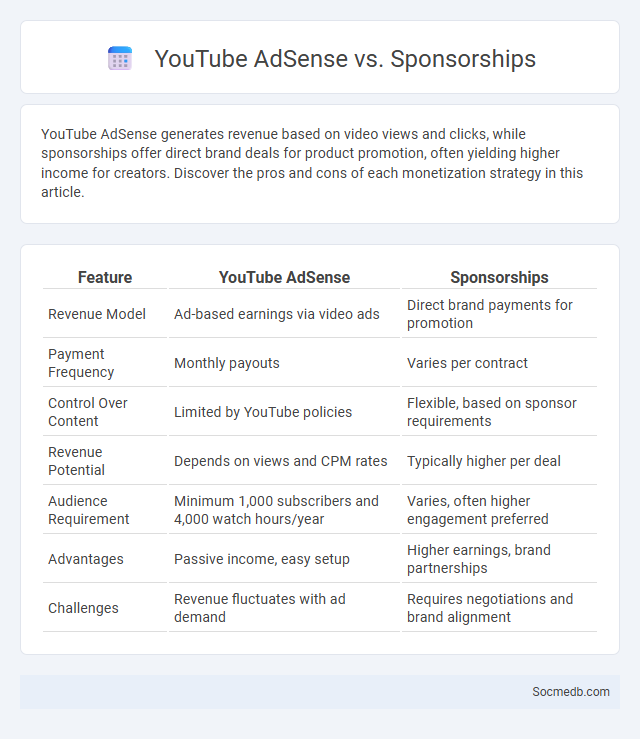
Photo illustration: YouTube AdSense vs Sponsorships
YouTube AdSense generates revenue based on video views and clicks, while sponsorships offer direct brand deals for product promotion, often yielding higher income for creators. Discover the pros and cons of each monetization strategy in this article.
Table of Comparison
| Feature | YouTube AdSense | Sponsorships |
|---|---|---|
| Revenue Model | Ad-based earnings via video ads | Direct brand payments for promotion |
| Payment Frequency | Monthly payouts | Varies per contract |
| Control Over Content | Limited by YouTube policies | Flexible, based on sponsor requirements |
| Revenue Potential | Depends on views and CPM rates | Typically higher per deal |
| Audience Requirement | Minimum 1,000 subscribers and 4,000 watch hours/year | Varies, often higher engagement preferred |
| Advantages | Passive income, easy setup | Higher earnings, brand partnerships |
| Challenges | Revenue fluctuates with ad demand | Requires negotiations and brand alignment |
Introduction: Monetization Options on YouTube
YouTube offers diverse monetization options including ad revenue, channel memberships, and Super Chat, enabling creators to generate income from their content. Your engagement in YouTube's Partner Program allows access to premium features like merchandise shelves and YouTube Premium revenue sharing. Maximizing these monetization methods can boost your earnings effectively.
Overview of YouTube AdSense
YouTube AdSense is a monetization platform that allows content creators to earn revenue by displaying ads on their videos. It operates through Google's AdSense program, which matches relevant advertisements to viewer interests using advanced algorithms. Channels must meet specific eligibility criteria, such as 1,000 subscribers and 4,000 watch hours in the past 12 months, to activate monetization features.
Understanding YouTube Sponsorships
YouTube sponsorships involve creators partnering with brands to promote products or services through dedicated videos or integrated mentions, often generating significant revenue. Successful sponsorships rely on aligning the creator's audience demographics with the brand's target market, ensuring authentic and effective engagement. Transparent disclosures and adherence to YouTube's advertising policies are critical for maintaining trust and compliance.
What is YouTube Ad Revenue?
YouTube Ad Revenue is the income generated from advertisements displayed on videos, shared between content creators and YouTube. Your earnings depend on factors like ad views, viewer demographics, and ad engagement rates, maximizing your potential to monetize video content. Understanding YouTube's monetization policies and optimizing video SEO can significantly boost your ad revenue.
Comparing Earning Potentials
Social media platforms offer varied earning potentials depending on your content type, audience size, and engagement rate, with influencers on Instagram and TikTok often earning through brand partnerships and sponsored posts. YouTube creators typically generate revenue via ad revenue, channel memberships, and merchandise sales, while Twitch streamers rely heavily on subscriptions, donations, and sponsorships. Understanding each platform's monetization mechanisms can help you maximize your income based on your unique content strategy and follower demographics.
Audience Engagement and Revenue Streams
Social media platforms drive audience engagement through interactive content, personalized experiences, and real-time communication, boosting user retention and brand loyalty. Effective engagement strategies, such as influencer collaborations and targeted advertising, convert active followers into revenue streams. Monetization options include in-app purchases, sponsored posts, subscription models, and data-driven ad revenues, making social media a lucrative channel for businesses.
Requirements for Monetization Methods
Social media platforms require your account to meet specific criteria such as a minimum number of followers, consistent content posting, and adherence to community guidelines for monetization methods like ad revenue, brand sponsorships, or fan donations. Verification of your identity and compliance with platform-specific policies are critical to unlock features such as in-app purchases, subscriptions, or partnership programs. Meeting engagement metrics including watch time or interaction rates helps maximize your earnings potential through diverse monetization streams.
Pros and Cons of Each Revenue Source
Advertising revenue dominates social media platforms by enabling targeted marketing with detailed user data, generating high profits but raising privacy concerns and ad fatigue among users. Subscription models offer steady income and exclusive content, fostering loyal communities, yet they limit audience reach and may deter casual users unwilling to pay. E-commerce integration drives direct sales through social shopping features, boosting monetization while risking user experience dilution and potential platform trust issues.
Strategic Tips for Maximizing Earnings
Leverage targeted advertising campaigns and utilize data analytics tools to identify high-conversion audiences, increasing ROI through precise content delivery. Collaborate with influencers and engage in affiliate marketing to expand reach and boost passive income streams. Consistently analyze platform algorithms and optimize post timing to enhance visibility and maximize user engagement for sustained revenue growth.
Conclusion: Choosing the Right Monetization Path
Selecting the ideal social media monetization path depends on aligning platform features with targeted audience behavior and content type. Leveraging influencer partnerships, affiliate marketing, or ad revenue streams maximizes income potential by capitalizing on engagement metrics and niche relevance. Strategic experimentation and data analysis enable creators and businesses to optimize revenue models within ever-evolving social media landscapes.
 socmedb.com
socmedb.com